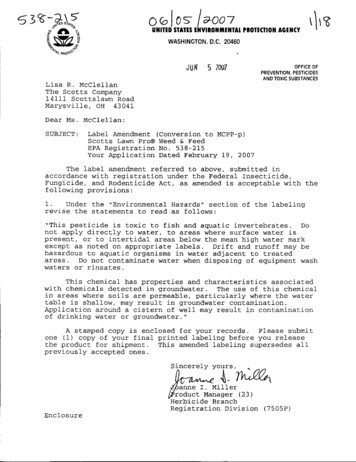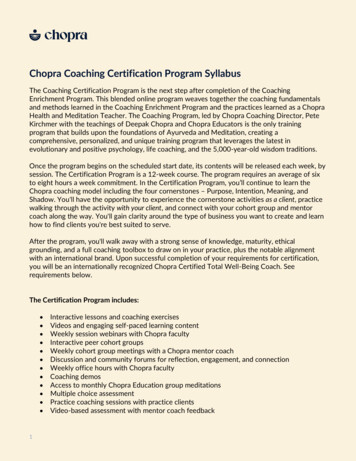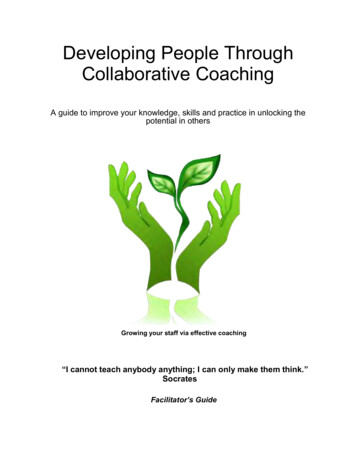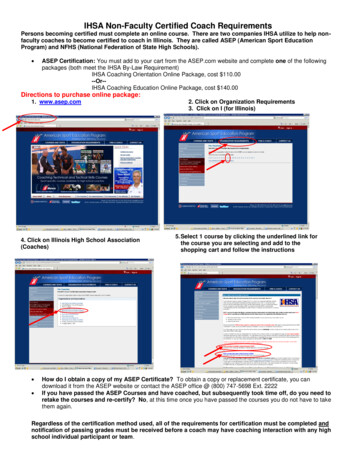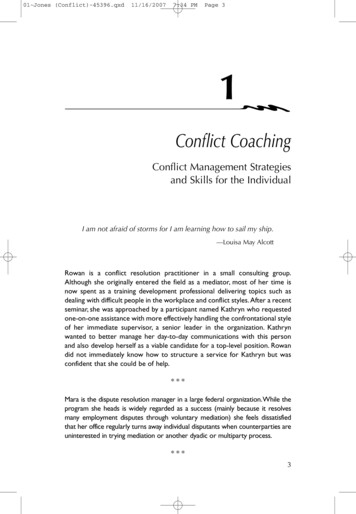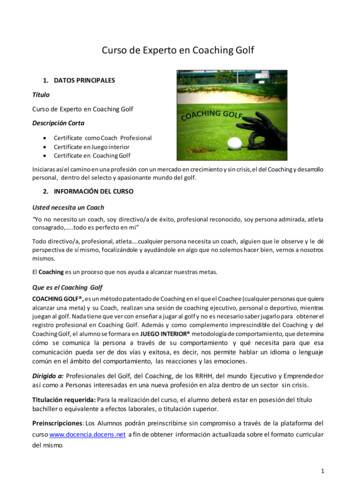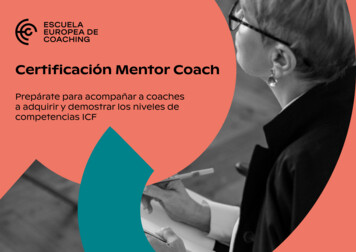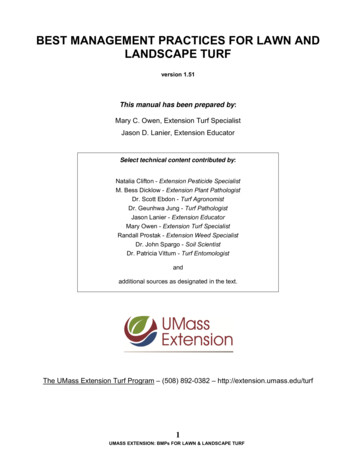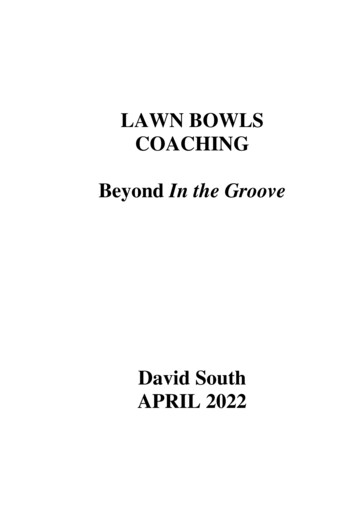
Transcription
LAWN BOWLSCOACHINGBeyond In the GrooveDavid SouthAPRIL 2022
Howitt Park Bowls Club, McEachern St East Bairnsdale 3875A pdf version of this booklet can be downloaded free fromhowittparkbowls@weebly.com
1INTRODUCTIONThere have been many books on how to play LawnBowls, perhaps starting with the Manual of BowlPlaying by W W Mitchell, first published in 1864 inGlasgow. Most books were written by someone whowas, or had been, a great player. Some simply give hintsabout things that have helped them, and some provide asystem.In the early 1960s, the Royal Victorian BowlsAssociation assembled a group of some of the bestplayers of the day, and asked them to put together aninstruction booklet, based on their consensus view as tothe best way to learn to play bowls. “In the Groove” waspublished in 1963. It was added to in 1971, and revisedin 2006, and is still in print. The foreword to the 2006edition of In The Groove notes that it is the definitivecoaching text in Australia. However, its first sentencenotes that the advice given is primarily for the beginner.In more recent times Bowls Australia has published anumber of Coaching Manuals, and developed coursesbased on these, which are delivered by the StateAssociations. These manuals are primarily about theprocess of coaching. Bowls Australia and various peoplehave published drills for practice sessions.When In The Groove was written, all bowls availablefollowed pretty much the same track, and this had notchanged for many years. Since the mid 1980's, a changeto the minimum bias standard, and the development ofnew ways of designing bowls, has led to the
2development of bowls that follow tracks that are quitedifferent from the track earlier bowls followed (SeeAppendices 1 and 2). To get the most out of these newbowls, you need to know a lot more about the forcesacting on a bowl, and the opportunities offered by thenew geometry.In recent times, various branches of science have beencalled on to assist in coaching at the elite level in manysports. Apart from the science of how to teach, thebranches of science most obviously relevant to LawnBowls are Physics, Biomechanics, and various aspectsof Psychology. Information from these areas can be usedby coaches to develop elite bowlers, and by bowlerswho want to become champions.This booklet is an attempt to provide this information.This booklet is written for a right handed bowler. Lefthanded bowlers will have to make the appropriatetranspositions.HOW WE LEARNDelivering a bowl is an example of what is called apsychomotor skill. An activity that involves veryprecise use of the muscles, controlled by the brain.Learning psychomotor skills involves creating, refiningand strengthening links between the brain and themuscles involved.These links are created by practice.
3When you practice, you should start with a "mentalrepresentation" of exactly what you want to happen.This should be a picture in your head of the result youwant to achieve. It can also be more than this. It caninclude an image of the track the bowl is going tofollow, and the pace it will be moving. It can include amental representation of the sensations of pressure andtension in all the muscles you use delivering a bowl. Itcan even include the feeling of being well balanced.Practice then involves trying to deliver a bowl so thatexactly what you have pictured actually happens. Younote the results, and then go through the whole processagain. As you do this, links are formed between whatyou are seeing on the green, the image in your head, andwhat your muscles actually do when delivering thebowl. At the physiological level, it may be that the brain"recognises" that certain pathways are being usedfrequently, and creates myelin sheaths as insulationaround these pathways, so that the signal can pass alongthem more readily, and with less interference.There are a number of implications for practising toimprove psychomotor skills:1.The three things that are important if skill is tobe increased to the highest level areA - a mental representation of what you want tohappen,B - an awareness of exactly what your musclesare doing as you deliver the bowl, andC - an awareness of exactly what does happen.
42.Repetition is critical for learning to occur. Youmust play the same shot over and over again.Since this is not what happens when you areactually playing a game, then playing a lot ofbowls games is a poor substitute for practice.3.Playing the same shot over and over again afteryou have stopped concentrating fully on whatyou are doing will not improve your skill atplaying it. Most people should practice for onlyhalf an hour at a time. If you really want to be achampion, then you could have a break, andcome back later for another half hour session. Ofcourse, there are people who have the ability tostay fully focused for longer, and they canbenefit from longer sessions.How much do you need to practice? Sports scientistsnow have as a general rule, that you need to repeat anaction 10,000 times before your performance peaks. IanSchuback, in his 2015 book, says when training forworld championships (of which he won 4) he practicedevery morning and afternoon six days a week - a total of21 hours a week. He suggests that if you want toimprove your game, a minimum of 3-4 hours a weekpractice is required. It's a big time commitment. Thatshouldn't be surprising - in most sports the top playersput large amounts of time into practice.That's practice. When you deliver a bowl during a game,you stand on the mat, look at the green, call up theappropriate image for the shot you have been asked to
5play, go through it in your head (cognitive rehearsal),and then just do it. You are "in the groove".It is probably best if you do this while standing on themat. However it is possible to do the "cognitiverehearsal" before you step on the mat. This will savetime, which could be important if you are playing to a"shot clock". You will see some very good bowlers whodo this, and then play the bowl very quickly when theystep onto the mat.Some aspects of the game of bowls involve a decisionmaking process, such as deciding what sort of shot toplay. It is very important to distinguish between learnedskills and decision making processes (which you alsohave to learn), because they are each controlled by adifferent part of the brain, and the way you learn to begood at each of them is quite different.You learn to be good at activity that involves a decisionmaking process by learning rules and then learning howto apply them. For instance, a skip needs to learn how tobuild a head, to maximise the chances that the team willfinish the end with the best possible result. Rules can belearned from a book, or taught by another person, andlearning to apply them is best done by observing whathappens in the various situations involved.You develop a high level of skill by practice.
6DELIVERING A BOWLOne of the first challenges to be overcome in deliveringa bowl consistently is that we deliver the bowl with onehand, which is to one side of the body. The force we useto send the bowl on its way can easily have a sidewaysmoment - that is, we will tend to throw ourselvessideways, and off balance, as we deliver the bowl.Unless we can control this tendency to fall sideways andforwards, our brains will take some action to prevent afall. And the action it takes can affect the track the bowltakes.This is not a problem unique to bowls. As toddlerslearning to walk, we learn to use muscles in our torsoand legs (core strength) to counteract the tendency tofall sideways that is inevitable when we walk by movingone foot forward at a time. This can be seen as apsychomotor skill, that we learn, and maintain, bypractice. We are all quite good at it, and do it quiteunconsciously.We can rely on a similar learned skill to keep ourbalance and deliver a bowl along the track we want it tofollow. It is an aspect of what is sometimes called "corestability". Most people have enough core strength andcore stability to play a draw shot on a fast green.Someone who is fairly young, and who does hardmanual work for a living, or has developed very goodbalance, may have enough to play any shot, on anypaced green. But to draw consistently on a slow green,or to play heavily weighted shots, many people need adelivery that will minimise the extent to which they
7throw themselves off balance, and thus minimise theextent to which they have to rely on core strength andstability.Your brain will not let you fall, and if necessary, yourbrain will do something to stop this happening. And itcan do it automatically. Most likely you will:1Swing your arm across the front of your body (toyour left), to counteract the tendency to fall to the right.This need not be a problem if you do it after the bowlhas left your hand, but will be disastrous if you startswinging before this has happened. You will hear thecry "I have pulled it".2Move your right foot forward and to your rightas (or immediately after) you deliver the bowl,3Move your head and shoulders upward andbackward and to the left just as you deliver the bowl.This restores your balance, but will normally cause thebowl to be short. You will hear people say "you arecoming up too soon" when this happens.4Reduce your follow through, to have a "flick"delivery. It is very hard to have a consistent line whenyou do this.5Drop the bowl from a foot or so above theground. Unless you do this in exactly the same way eachtime, your length will be inconsistent. And you maydamage the green.
8One effective way to minimise the tendency to fallsideways is to deliver the bowl so that your weight is asclose as possible to directly over your front foot at themoment the bowl leaves your hand. This will minimisethe sideways component of the delivery action. It does,however, have important implications for where yourfeet have to be when you step forward.The rules say you must startwith you right foot on orpartly on the mat. It does notactually matter where yourfoot is on the mat. Differentpeople have differentpreferences. You must thenidentify the track the bowl willfollow when it leaves yourhand. The hand holding thebowl, and the bowl, will bedirectly above one point onthe track that the bowl is tofollow when your hand is byyour side. For most people theBackhand foot positions track will be about 50 mm (2inches) away from their right foot, but it may be furtherfor people with wide hips. You then envisage the trackthe bowl will follow as you deliver it, and step forwardwith your left foot, to a point just to the left of the trackthe bowl is to follow.
9Since for a backhand shot the track the bowl is to followwill be at an angle to your left. then a step forward to apoint just left of this line is not far from a step straightforward.However, for a forehand shot,the track the bowl is to followwill be at an angle to yourright, not to your left. Againyou start with your right footjust to the left of the line thebowl is to follow, and parallelto it. Again you have to moveyour left foot as you stepforward to a point just to theleft of the track the bowl willfollow, but this time this actioninvolves a step quite markedlyto your right rather than a stepForehand Foot Positions that is almost straight forward.Quite different.It is quite important even for beginners to understand thedifferent steps forward for a backhand and a forehandshot. Unless this is impressed on them they may stepforward in the same way for backhand and forehand.One or the other will tend to throw them off balance,which will be uncomfortable. They will tend to preferthe hand at feels comfortable, and so will have a distinctpreference for either the backhand or the forehand.
10You then deliver the bowl. passing you hand as close aspracticable to the edge of your foot. How close this iswill vary from person to person. If your foot is inexactly the right spot you will find that you can deliverthe bowl with a full follow through without feeling offbalance. You do not watch your feet as you bowl, ofcourse, so you need to practice the step forward untilyou can step to the exact right spot without watchingyour feet, and without even thinking about it. Initiallyyou may need to have someone watch your stepforward.You will find when you step out in this way that there isnatural tendency for your right knee to move behindyour left knee as you move forward.You can also counter the tendency to fall sideways byputting your left hand on your left knee as you deliverthe bowl. You then use the muscles in your arm tocounter the tendency to fall sideways. And you can stepforward with your front foot at an angle to the line thebowl is to take. You can then use the muscles in yourfoot to counter the tendency to fall sideways.Sometimes people who want to bowl are not able – forvarious reasons – to deliver a bowl in the conventionalway, or who are not able to play at their best doing this.There are various unconventional ways to deliver abowl, however, that can work almost as well. A clubcoach should be able to assist someone in this positionto adopt an appropriate strategy.
11The most common is the use of a Bowlers Arm. Thisallows you to deliver a bowl without bending, andbecause the Arm functions as an extension of the lengthor your arm, you can deliver a bowl with quite a lot ofpace with much less effort. Because you don’t use yourfingers you will never have the fine control of pace in adraw shot on a fast green, but if you are having troubleputting enough pace on the ball on a slow green or for adrive shot, or maintaining a consistent line in playingsuch shots, you will be able to do better with an Arm.GETTING ENOUGH PACE ON THE BOWLDelivering a bowl involves using a number of differentmuscle groups, and bowlers vary in the way theycombine the various muscles involved.1You use the muscles in your shoulder, arm, wristand hand. You will see bowlers who use a "fixedstance", kneeling down on one knee before commencingthe delivery. Or stepping out to the side, so that theirfeet are well apart when they deliver the bowl. They areonly using muscles in their shoulder arm, wrist andhand.2You can twist your body as you deliver the bowl,much like golfers do. This is using muscles in yourabdomen and back. This is fine, but as you get olderyou may find that you can’t do it as well.3You can be moving forward as you deliver thebowl. You can do this in such a way that your weighttransfers from your back foot to your front foot at the
12moment - or just before - you actually release the bowl.This adds a surprising amount of pace to the bowl. Ifyou do this you must ensure that you do it every timeyou deliver a bowl. Some people will generally transfertheir weight forward when they are feeling confident,but stop doing it if their confidence drops. We all knowsome "front runners" who will play well when they arewinning, but play less consistently when they fallbehind.Some players walk off - or even run off - the mat as theydeliver the bowl. This imparts a good deal ofmomentum to the bowl. Some bowlers will run off themat during the delivery when they play a drive shot, butnot otherwise. This is a very effective way to put a lot ofpace on the bowl.4You can start with your arm fully extendedbehind you before you start the delivery, and/or take alonger step forward. If you apply a constant force withthe muscles in your shoulder and arm - even if quite asmall force - then because your arm is moving a longerdistance, it accelerates to a faster pace. You do need astrong hand to control the bowl when your arm ismoving quickly.You can vary the pace on the bowl - and how far it willtravel - by varying the amount of backswing, or thelength of your forward step. For a draw shot on a shortend on a fast green, you would use very littlebackswing, and take a short step. For a weighted shot ona long end on a slow green, you would use a big
13backswing and/or take a longer step. "In the Groove"calls this the Theory of Elevation.5If you start the delivery with your arm straight that is, not bent at the elbow - behind you, then at somepoint during the delivery action you can bend yourelbow, thus applying force to the bowl with the musclesin your arm.6If you start your delivery with your wrist"cocked" - that is bent backward - then when youstraighten your wrist, and move your hand forward, youuse the muscles in your wrist to apply force to the bowl.7If you give a final push with your fingers just asthe bowl leaves your hand, this adds force to the bowltoo.You will find bowlers who only use some of thesemuscle groups to deliver a bowl, and some who use allof them, but to a different degree. Research in the fieldof biomechanics has shown that to have the maximumdegree of precise control of the force applied, youshould use all the muscle groups involved, and use themall at the same time. However you deliver a bowl, youneed to deliver it exactly the same way each time. Thistakes a lot of practice.Whichever muscles you use to deliver a bowl, it isimportant that the final force on the bowl as it leaves thehand is applied with the fingers. Because the ends ofyour fingers have more nerve endings than other parts of
14your body, then if the final force is applied to the bowlwith your fingers you will have more precise controlover exactly how much force is applied, which will leadto more control over exactly how fast the bowl istravelling. Applying the final force with the fingers willalso make the bowl start spinning before it hits theground. If you don’t do this it will slide along the greenfor a short distance before it starts rolling, and unless itslides for exactly the same distance each time, both yourline and your length will be inconsistent. "Slidingfriction" is much greater than "rolling friction."There are some other aspects of the delivery that willgive you more control.1.Develop a smooth steady action with a longfollow-through. This will be more easily controlled thana delivery that involves jerks or flicks, no matter howmuch pace you are giving the bowl. And it will enableyou to control more precisely the direction the bowl istravelling in when it leaves your hand.2.Place the bowl on the turf rather than drop it. Ifyou drop the bowl onto the turf you have to do it inexactly the same way each time. More practice willimprove your ability to drop the bowl in a consistentway, but you will never be as consistent as someonewho places the bowl onto the turf.3Get it away without a wobble. This requires thatthe plane of the running surface of the bowl as the bowlleaves your hand is in line with the track the bowl is to
15follow. If the bowl wobbles for its first few metres, yourline and length will be inconsistent, unless you wobble itin exactly the same way each time. It doesn't reallymatter where your fingers are on the bowl, but it is bestif they are in the same place every time.4Ensure the plane of the running surface of thebowl is vertical when you release it. If the bowl isleaning outward when you deliver it, it will take anarrower track. You will find some people who alwaysseem to put the bowl down on a narrower track thanothers, even with the same model of bowl. Thisgenerally means they deliver a bowl with a slightoutward lean on it. Some people do this deliberatelywhen they want to bowl to take a particularly narrowtrack - they call it "standing the bowl up". It can be auseful skill, but you have to practice it a lot to be able todo it consistently.If you are not consistent in the way you deliver thebowl, then it might be worth getting a coach to watchyour delivery action, and suggest changes you couldmake.PRACTISING THE DELIVERYThe first, and perhaps most important thing you need topractice is your delivery action. Take your bowls ontothe green, and try to deliver the bowl in exactly the sameway, maintaining perfect balance, for about half an hour.Don’t worry about where the bowl finishes. Yourobjective is to be able to deliver the bowl in exactly theway you want to without thinking about it, and to do it
16in the same way every time. And you should try to useall the muscle groups involved, at the same time, tomaximise control of the pace.THE DRAW SHOTThe draw shot at its most basic involves delivering thebowl to come to rest exactly as it reaches the jack. If youget the line right, and the pace right, it will do exactlythat.Getting the line right1The method of getting the line right you willnaturally use if you have played many other ball sportsis to picture the actual track the bowl will follow, anddeliver the bowl so that it will follow this track. You cando this either by picturing the whole track, or looking atsome point on that track. The shoulder, being the pointwhere the bowl is furthest from the centre line, is acommon point, but it could even be the jack. You thendeliver the bowl so that it will follow this track, or passover the point you are looking at. You are not actuallyputting the bowl down aimed directly at the point youare looking at. If you did, it would be narrow everytime. Your brain makes an automatic adjustment, andyou actually put the bowl down heading towards a widerpoint. Probably without realizing you are doing this. It isimportant to realize that if you use this method, youmust not try to put the bowl down heading directly at thepoint you are looking at. Trust your muscle memory – ifyou have done enough practice, your brain will knowhow much adjustment in the line you have to make. Andyou don't have to worry about having your eyes directly
17above the track the bowl is to follow. Your brain canadjust for this.This is basically the technique used in many sports. Abowler in a game of cricket looks at the point on thepitch that they want the ball to land on, and relies onmuscle memory to control the way the ball leaves thehand to achieve this result. A darts player looks at thepoint on the darts board where they expect the dart toland, but the dart actually leaves the hand travellingtowards a point above this, since it too will follow acurved path. People who come to bowls after playingsuch sports will often have developed the skills toconcentrate on the result they want to achieve, and relyon muscle memory to control the direction the bowl isactually traveling in when it leaves their hand. This issometimes called "having a good eye".The track your bowls will follow may be very differentto the track other bowls will follow, and very differentto the track your bowls will follow on a differentsurface. You need to practice on all types and pace ofsurface. If you have done too much of your practice on aparticular green, you will find it difficult to adjust to acompletely different green. The locals will then have abig home green advantage.If the point on the track you are looking at is not very farin front of you, the direction the bowl follows as itleaves your hand is very close to directly towards thispoint. The bowl doesn't move sideways very much untilit slows down, so it looks as though it is travelling in astraight line for the early part of its journey.
182There is an additional tactic you can add to thisto ensure you get your line exactly right.You identify a point you can aim directly at, and deliverthe bowl as though it had no bias. The bowl will startturning before it reaches this point, of course, so it won'tactually follow the line. Your aiming point will beoutside the track the bowl actually follows. The aimingpoint can be on the bank, a point on the green the samedistance away as the jack, or a point a couple of metresin front of you. Any point on the line will work. Duringyour delivery, you then concentrate on your followthrough, and watch the bowl to ensure that it leaves yourhand heading straight towards your aiming point. Thiswill be easiest if you have a full follow through, andyour head is low to the ground at the point of delivery.How wide the aiming point is depends on the pace of thegreen, and what bowls you have. You identify your fouraiming points (the points you look at for a draw shot oneach hand, in each direction) during the roll up. The lineto the aiming point will be at the same angle to thecentre line for short and long ends.If you use a point on the bank as your reference point,then you need to be aware that if the mat is broughtforward, this point will be a bit closer to the centre line.There are advantages in picking an aiming point thesame distance away as the jack (but off to one side, ofcourse). This gives you an idea of how much pace youhave to give the bowl. Note that because the bowl
19follows a curved path, the distance it has to travel toreach the jack is about 5% more than if it travelled in astraight line. So your aiming point is one to two metres(depending on whether it is a short or long end, and thepace of the green) past a point that would be jack-level.If you are playing in a strong wind that is blowing alongthe rink rather than across it (a headwind one way, and atail wind the next end) then it may help initially to setyour aiming point well short of its normal position for atail wind, and well past it for a head wind.Aiming at a point the same distance away as the jackalso makes correction of your line if you are narrow orwide easier. If you finish a foot narrow, you can correctthis by aiming at a point about a foot wider than lasttime. If you are a metre wide, you simply move youraiming point about a metre towards the jack. You usethe same process to draw to a jack that has moved to oneside, or to draw to a position.Practice involves picking your point, and putting bowlsdown aimed directly at it, with just enough pace to reachit. If you can do it consistently, then all you have to doto draw accurately when you start a game is to find yourfour aiming points. It won't matter what pace the greenis running at, what kind of surface it is, whether there isa wind, or whether the green has "runs" in it.Getting the pace right.Getting the pace right is the hardest part of the game.Some books on bowls talk about the theory of elevation.This is based on the notion that if your swing follows a
20longer arc, and takes much the same time to execute,then the bowl will leave your hand travelling at a fasterpace. And the pace will roughly depend on the length ofthe arc. So for a faster pace (long end, slow green) youcould start with the bowl held high in front of you, takea big backswing, and/or a longer step. If you are takingthe same time to deliver the bowl, the bowl will thenleave your hand travelling at a faster pace. Some peoplehum a song to themselves while delivering the bowl.This is quite a good way to ensure you take the sametime to deliver each bowl.An effective aid to taking a longer step for a long end isto start the delivery action with your left foot furtherback than your right foot. For a short end, you start withyour left foot further forward.Information on pages 11 to 14 can also help you controlthe pace of the bowl.A more precise way to get pace exactly right.These processes work (particularly if you are using aBowlers Arm), but on their own are not enough to makeyou a top bowler. You need to refine the skill in gettingthe pace right through practice, as described on page 4.Practice creates a link between your image of how faryou want the bowl to travel, and what your muscles doin delivering it. There is no substitute for a lot ofpractice to be able to get your pace right.The degree of fine control you can develop is related tothe strength of the link between the image and thesensations in your muscles. Your fingertips have more
21nerve endings than your hand or arm, so you will beable to develop more control if you always deliver thebowl with your fingertips – and concentrate particularlyon the sensations in your fingertips when you arepracticing.Slow greens – and weighted shots – involve extra forceby some or all of the muscles involved. You have tolearn to coordinate the muscles involved by practice.What that means is that practicing a draw shot on a 17second green will not help you much when you play ona 12 second green. You need to do some practice onslow greens.You must be able to call up a strong and precise imageeasily. You can improve your skill at this, by practisingit. And you don’t actually have to be on a bowling greento practise getting your images clear and strong. If youhave the ability to do it, and enough experience, you canprobably do a lot of your practising without going near abowling green.SHOTS WITH MORE PACE THAN A DRAWSHOT.For other than draw shots, the bowl will follow adifferent track. One approach to getting the line andpace right for such shots is to envisage the track youwant the bowl to follow, and identify the point the bowlwould finish if there was nothing in the way. You thendraw to that point.
22Otherwise, you will have to envisage the track the bowlwill follow, and the pace it will need to be travelling atto achieve the result you want, and deliver the bowl sothat it follows that track. You practice this shot byplaying it over and over. The track it will follow will bedifferent for different types of surface, and for differentpaced greens. To be able to visualize the trackconsistently, you will need a lot of experience, andpractice, on different paced surfaces, and different typesof surface. You can also help get the initial line and paceright by envisaging a spot on the green that you candeliver the bowl directly at, with just enough pace toreach it. The point this time is not same distance fromyou as it would be for a draw shot. The figure on thenext page may help determine exactly where such apoint would be.Point A is the mat. B is the point you want to draw to, orplay through. Point C is the aiming point for a drawshot. To draw a resting toucher, you would deliver thebowl along Line AC – that is, directly towards C, withjust enough pace to
coaching text in Australia. However, its first sentence notes that the advice given is primarily for the beginner. In more recent times Bowls Australia has published a number of Coaching Manuals, and developed courses based on these, which are delivered by the State Associations. These manuals are primarily about the process of coaching.
